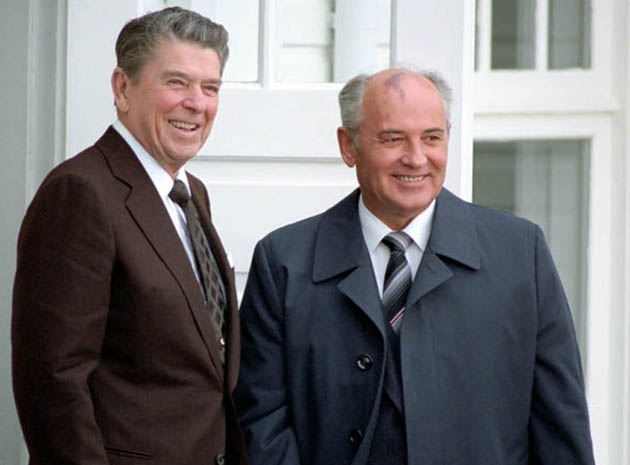On October 11, 1986, halfway between Moscow and Washington, D.C., the leaders of the world’s two superpowers, Mikhail Gorbachev and Ronald Reagan, met at Höfði in Reykjavik, Iceland. The topic of the meeting was the future elimination of nuclear weapons. Initiated by Gorbachev less than thirty days before, the expectations for the summit at Reykjavik were low. Reagan and Gorbachev established a personal relationship at their Geneva Summit one year prior. In Geneva, they attempted to agree on bilateral nuclear arms reductions. Since then, their negotiators have reached an impasse. Both leaders hoped a face-to-face meeting at Reykjavik might revive the negotiations. This session was planned to limit each country’s strategic nuclear weapons and improve the ongoing arms-control situation.

The talks between Reagan and Gorbachev at Reykjavik proceeded at a breakneck pace. Gorbachev did something no previous Soviet leader had ever done before. He acknowledged human rights issues as a legitimate topic of discussion. For the first time in history, a proposal to eliminate all new strategic missiles gave hope of eliminating nuclear weapons forever. The plan was to do it in three stages by the year 2000, which would have drastically changed the military strategies of both countries. The proposal by Reagan was to withdraw INF (Intermediate-Range Nuclear Forces) weapons from Europe. The Soviet side suggested eliminating half of strategic arms, including ICBMs (InterContinental Ballistic Missiles). The agreement also excluded British and French weapons.
Aides to both leaders were shocked by the pace of the discussions. A summit that began with low expectations had blossomed into one of the most dramatic and potentially productive summits of all time. The plan was to have an informal session on some topics, yet Gorbachev came out with dramatic proposals regarding all aspects of the U.S.-Soviet nuclear arms negotiation. After the first session, on October 11, a subsequent all-night meeting between senior officials occurred and concluded fundamental strategic offensive forces limiting parameters. During the next day’s session, Gorbachev added to his proposal to limit all U.S. and Soviet intermediate-range missiles to 100 for each side. Although a significant consent on offensive forces was almost completed, everything depended on a decision regarding ballistic missile defense.
When the participants turned to this question, Gorbachev proposed an extra session in the afternoon to discuss the issue. During this session, chaired by the foreign ministers, the Soviet Foreign Minister Eduard Shevardnadze insisted on 10 years of non-withdrawal from the ABM (Anti-Ballistic Missile) Treaty. If this could be agreed, all other issues could be solved.
But one point of contention remained. Reagan was committed to completing his Strategic Defense Initiative (SDI). Gorbachev, fearing an imbalance of power, was equally determined to ensure SDI would never be implemented. Reagan assured Gorbachev that the missile defense shield, which he had championed and funded despite widespread criticism at home, was being developed not to gain an advantage but to offer safety against accidents or outlaw nations. Reagan offered to share this technology with the Soviets many times, which Gorbachev refused to believe.
Toward the end of the long and stressful final negotiations, Gorbachev would accept continued development of SDI as long as testing was confined to the laboratory for the next ten years. Reagan would disagree. He could not and would not allow the division of his two-part strategy of simultaneously eliminating nuclear weapons by creating a missile defense shield. On the other hand, Gorbachev could only afford to implement significant reforms in his country with assurances about national security.
After the negotiations terminated without a final agreement, Reagan considered it a very frustrating moment in his career. He later wrote how close he felt to achieving this long-term goal of eliminating the threat of nuclear destruction. As a result of this agreement, the Soviet and American atomic weapons stockpiles would have been decreased by 2000. Reagan even described to Gorbachev how they would personally witness the demolition of the world’s last remaining nuclear warhead in ten years. But Gorbachev’s proposal to limit research to laboratories was considered an attack on the missile defense program by Washington.

Despite its failure to accomplish the ultimate goal, the Reykjavik summit is recorded as one of the most important ones in history. Following this meeting, the United States and the Soviet Union signed significant agreements, marking the beginning of the end of the Cold War. First was the Intermediate-Range Nuclear Forces Treaty (INF), a year after Reykjavik, that required both sides to liquidate a whole class of nuclear weapons. A few years later, during H.W. Bush’s presidency, another treaty was signed – The Strategic Arms Reduction Treaty (START). This agreement banned the deployment of 6,000 nuclear warheads, 1,600 intercontinental ballistic missiles, and bombers.
It is important to note that this progress was only possible with two leaders’ courage. They tried to look beyond past hostilities and forge a new and lasting relationship to provide greater security for people worldwide. Although many things have changed after the Reykjavik Summit, both countries are still hedging their nuclear weapons programs. With the new weapons, new threats have emerged, such as Iranian and North Korean nuclear weapons programs that were not considered issues in the 1980s.
